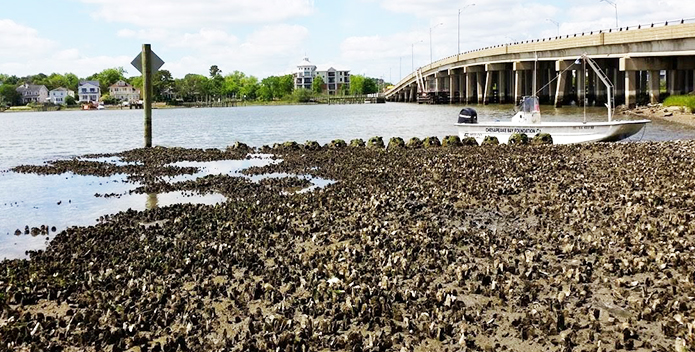The following first appeared in the Bay Journal.
Near the mouth of Norfolk's Lafayette River last July, a crane lifted a load of crushed concrete off a barge and released it into the water. Five boats bobbed in the waves, each full of volunteers and federal, state, and local officials. Together, they tipped orange bushel baskets overboard, planting oysters on top of the recently placed concrete.
The group of 75 people was celebrating a cooperative effort that is transforming this small river. The Lafayette could soon be the first river in Virginia to meet its oyster restoration goal, one of 10 that were set for tributaries Baywide. The 4.5-acre reef being built that day makes for a total of 75 acres of reefs on the river, just shy of its 80-acre target.
It is all part of an amazing comeback for the Lafayette, an urban waterway entirely within Norfolk city limits. Longtime residents describe a river once plagued by sewage, trash, and stormwater runoff. But restoration work on land and in the water is bringing a host of environmental, economic, and social benefits.
Today, boaters, kayakers, and paddle boarders commonly ply the Lafayette's waters. Fisherman cast for redfish and speckled trout over newly constructed oyster reefs. Biological surveys on the river find a rich diversity of aquatic life, ranging from blue crabs and black sea bass to bay anchovies and seahorses. Just last year, the Lafayette was taken off Virginia's list of waterways impaired by bacteria.
The Lafayette is just one of several Virginia rivers experiencing the benefits of oyster restoration. For example, on the Lynnhaven River, better water quality has ignited an aquaculture industry that, combined with dozens of acres of new sanctuary reefs, has provided much-needed improvements in habitat and water clarity. A 25-acre sanctuary reef with a granite base was constructed this summer on the Piankatank River.
These sanctuary oyster reefs also serve as brood stock that boost watermen’s harvests. The current carries offspring from these oysters to new places, where they colonize areas open to harvest. These reefs are also a refuge for crab and fish populations that help sustain watermen.
John Meekins, a full-time waterman on the Lynnhaven, said oyster restoration is good for business. He noted that restoration work has led to more oysters growing on sites he harvests. "There are areas I can harvest year-round that I used to only harvest a few months a year in the past," he said.
While many have grown accustomed to picturing the Bay’s waterways with largely flat and featureless bottoms, oyster restoration efforts may provide a welcome surprise. As oysters grow on top of each other, they form three-dimensional structures. Oyster reefs, with their many small caves and crevices between oyster shells, anchor thriving ecosystems that include underwater grasses, a variety of crabs, sponges, small invertebrates, and fish. Historically, these diverse and highly productive communities rivaled the coral reefs of tropical seas.
Although oysters naturally latch onto the shells of other oysters to build reefs, many other options are available for restoration. Building a new reef entirely out of shell uses a huge amount of this precious resource—and there just isn’t enough to go around.
On the Lafayette, new reefs have been built on a bed of crushed concrete that keeps oysters from being buried under the shifting sand and silt on the river bottom. Spat-on-shell oysters are planted on top of this base. This is working beautifully. Surveys on the Lafayette show that new reefs on crushed concrete have about the same oyster density as those on natural materials.
This summer, the Chesapeake Bay Foundation installed 600 oyster reef balls in the Lafayette River. Nearly 1,500 have been added to the river since 2010. These large hollow concrete domes build up three-dimensional structure quickly, jump-starting a whole new ecosystem. They are dotted with big holes, creating hiding places for aquatic life and plenty of area for oysters to latch onto. In fact, a recent CBF survey found more than 2,000 oysters on average growing on a single 18-inch-diameter reef ball.
The progress in bringing back Virginia’s oyster population shows what can be done when everyone pitches in. For example, successes on the Lafayette wouldn't have been possible without federal investment from the National Oceanic and Atmospheric Administration, the Army Corps of Engineers, and the National Fish and Wildlife Foundation, as well as support from Virginia, the City of Norfolk, the local community, and conservation groups including the Elizabeth River Project and the CBF. Continued state and federal investment will be vital to ongoing success.
"The remarkable turnaround in the Lafayette River is a testament to what can be accomplished when motivated, focused, and informed partners work together to achieve a common objective," said John M. R. Bull, head of the Virginia Marine Resources Commission. "This commitment to returning oysters to their natural role in the ecosystem, for the benefit of all, has been a labor of love."
Chris Moore
Issues in this Post
Chesapeake Clean Water Blueprint Chesapeake Clean Water Blueprint Conservation Eastern Oysters Fisheries Restoration Water Quality CBF in Virginia



